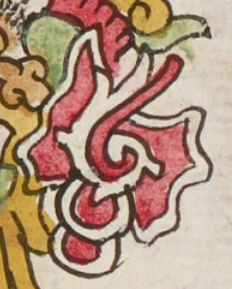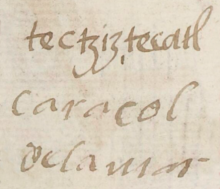tecciztli (TR19r)
This element for a conch shell/trumpet (tecciztli) has been carved from the name of the divine force or deity Tecciztecatl ("Conch-Shell Lord"). It shows a conch shell in cutaway form (or section view), revealing the inner swirls, which are red with white edges.
Stephanie Wood
A sign next to a tecciztli at the Templo Mayor refers to the shell as a "turbinella angulata" and a large "gastropod shell...from the Atlantic coast of Mexico." It continues, "The presence of several specimens of the periostracum, a protein layer that covers the shell's surface, attests to the fact they were collected alive by divers, because this layer is lost when the animal dies in the sea and is dragged onto the beach by the swell of waves. A specimen of this species was found covered with blue pigment, perhaps to emphasize its relationship with water, in one of the offerings dedicated to Tlaloc. It also served for the production of a large number of objects includeding the ehecacozcatl, the pectoral characteristic of the god Ehecatl-Quetzalcoatl, which is produced by transversally cutting the shell's spiral whorls. Beads and pendants made of this shell have also been found."
Stephanie Wood
tectziztecatl
caracol
delamar
Tecciztecatl, caracol de la mar
ca. 1550–1563
Jeff Haskett-Wood
shells, conchas, caracoles
Photo, by Robert Haskett, taken at the Templo Mayor, 15 February 2023.

tecciz(tli), conch shell/trumpet, https://nahuatl.wired-humanities.org/content/tecciztli
la concha, el caracol
Stephanie Wood
Telleriano-Remensis Codex, folio 19 recto, MS Mexicain 385, Gallica digital collection, https://gallica.bnf.fr/ark:/12148/btv1b8458267s/f63.item.zoom
The non-commercial reuse of images from the Bibliothèque nationale de France is free as long as the user is in compliance with the legislation in force and provides the citation: “Source gallica.bnf.fr / Bibliothèque nationale de France” or “Source gallica.bnf.fr / BnF.”


